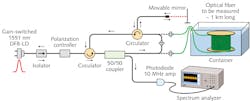Long single-mode fiber optical lengths measured to micrometer-level precision
Measuring the optical length of a relatively long section of single-mode optical fiber in situ, for example in a remote-sensing or communications application, can currently be done using the time-of-flight (TOF) method to a resolution of a few millimeters or so, limited by the speed of the photodetector response or by optical time-domain reflectometry (OTDR), although with even lower resolution over kilometers-long fibers. Now, researchers at Osaka Prefecture University (Osaka, Japan) have developed a simple and more-precise method for measuring fiber length based on the use of a gain-switched pulsed distributed-feedback (DFB) laser with optical delayed feedback—a method that, without the need for a fast photodetector, measured the optical length of a 1 km single-mode fiber immersed in water to be 1471.043915 m ±33 μm with a measurement time (over which many individual measurements are averaged) of approximately 1 min.
The laser itself generates a pulse train with a 1 GHz repetition rate, a pulse width of 28 ps, and a 0.7 nm spectral width at a 1550 nm wavelength. In the technique, a portion of the DFB laser's output pulse is fed back into the laser, producing fluctuations in the amplified spontaneous emission (ASE) noise intensity with respect to the modulation frequency of the gain switching. A cross-correlation trace is done between the pulse inside the laser cavity and the feedback pulse (which contains information about the fiber's optical length). In effect, the DFB laser is used as a time-gated picosecond detector. The researchers were able to measure variations in the optical length over a 41 h time span resulting from temperature variations, showing a variation of 280 μm/°C. Reference: K. Wada et al., Opt. Express (2015); doi:10.1364/OE.23.023013.
About the Author
John Wallace
Senior Technical Editor (1998-2022)
John Wallace was with Laser Focus World for nearly 25 years, retiring in late June 2022. He obtained a bachelor's degree in mechanical engineering and physics at Rutgers University and a master's in optical engineering at the University of Rochester. Before becoming an editor, John worked as an engineer at RCA, Exxon, Eastman Kodak, and GCA Corporation.

